If there was a creature that could send you from aww to awe in a wink, it would be the majestic Tibetan Mastiff. Your Tibet trip remains incomplete if you do not experience these regal dogs in the land of their origin. They embody the heart and soul of the region, reflecting its resilience and unique character.
While Tibetan Mastiffs have ventured across the globe, the true essence of the OG Tibetan Mastiffs can only be found on the high-altitude Tibetan Plateau. So be sure to check them out on your next Tibet trip!
Appearance of Tibetan Mastiffs: What do They Look Like?
From afar, Tibetan Mastiffs are a furry blend of cuddly charm and imposing might, reminding you of ancient fluffy beings like woolly mammoths. Up close, a fully grown adult male stands tall at heights up to 33 inches with a sturdy build and strong muscles rippling across its limbs and torso.
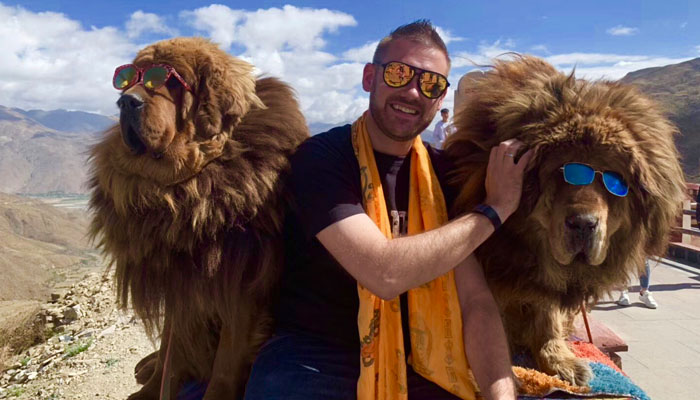 The Tibetan mastiffs are charming and imposing.
The Tibetan mastiffs are charming and imposing.Their weight ranges from 45 to 70 kilograms and their astonishing double coat rival even the most seasoned winter explorer. They sport an attractive hair coat around their neck like a lion's mane.
In the Tibetan plateau, these dogs come in two distinct versions - the Drog-Khyi, the nomadic type with its powerful musculature that roams freely with a fearless aura, and the Tsang-Khyi, the monastery guardian, heftier and with more pronounced facial traits.
The coat colors range from "fire" (brown-red) and "snow" (pure white) to "Black & Tan" (black back with red hooves), "yellow" (golden), and "black" (black with slight white markings on chest and limbs). Other charming details are their high-held bushy tails, wise and expressive eyes, and endearing wrinkles.
Temperament of Tibetan Mastiffs: Are They Dangerous?
Tibetan Mastiffs are a striking mix of loyal companions and steadfast guardians. Despite their imposing size, they possess a protective yet gentle nature, making them exceptional watchdogs and cherished family members.
Their self-reliant nature combines with intelligence and a strong will, resulting in a breed that is both watchful and independent. The harsh Tibetan plateau molds them into resilient protectors with a king-like demeanor - dignified, brave, and loyal.
 Tibetan mastiffs are cherished family members in Tibet.
Tibetan mastiffs are cherished family members in Tibet.Their loyalty extends to their family, and they can be particularly protective of children. As guards, they are unwaveringly faithful and formidable. Yet, like a tiger, their tail can be sensitive, so refrain from grabbing them while they are around. While puppies might display unexpected destructive behavior, their loyalty remains intact. Their strong bite force and ability to navigate barriers show their strength.
They are social with known faces but may see strangers as intruders, so approach with caution, and only when accompanied by their master. With a high IQ and independence, they prefer their own rules over repetitive obedience training.
Tracing the History of Tibetan Mastiff
Bred across millennia to endure the Chang Tang Plateau's frigid challenges, these dogs are one of the ancient dog breeds in the world. Historical records dating back to the Spring and Autumn Period (771 BC - 476 BC) highlight how nomadic people (Qiang) tamed these wild dogs to counter assaults from other creatures, laying the foundation for the earliest Tibetan Mastiff. Chinese literature dating back to 1100 BC mentions large dogs which might be the forefathers of the present Tibetan Mastiffs.
Treasured by Tibetans, tales of every kind followed this dog's bushy tail everywhere. Some believe these dogs guard monasteries because their souls mirror the monks and nuns who didn't reach Shambhala, the celestial paradise. Another legend portrays them as reincarnated souls protecting people and land.
Another story stresses the dog's divine status as a heavenly mount of God who came down to earth to revive a land buried under perpetual snow and ice and plagued by illness. In the Himalayas and Central Asia, these mastiffs are part of the family trinity, prized alongside horses and sharp knives.
Discovering the Habitat of Tibetan Mastiff
These canines have roamed the Himalayas and alpine Tibetan Plateau for over 2000 years, adapting to high altitudes of 3000-5000 meters. They thrived in the harsh Tibetan Plateau environment developing enduring qualities in the face of hunger, cold, and adversity resulting in a resilient breed unfazed by any danger.
 Tibetan Mastiffs mostly live in the harsh Tibetan Plateau.
Tibetan Mastiffs mostly live in the harsh Tibetan Plateau.The dog's remarkable ability to navigate the high altitudes of Tibet without succumbing to hypoxia, or insufficient oxygen levels in the lungs, is attributed to its lower hemoglobin levels. Researchers have discovered that Tibetan mastiffs owe their enhanced oxygen storage capabilities to a gene shared with wolves, enabling their red blood cells to operate more effectively.
This unique adaptation allows them to survive and flourish in the oxygen-scarce atmosphere of the plateau. The Tibetan Mastiff's physical and physiological changes underscore their exceptional evolutionary journey in the unforgiving landscape of the Tibetan Plateau.
Important Role of Tibetan Mastiff in Tibetan Life
From monasteries to family houses, nomadic tents to pastures, Tibetan Mastiffs are deeply embedded in every fold of Tibetan culture. Its loyal nature gives it a crucial role as the guardian of herds, homes, and families. Their significance transcends mere utility, intertwining with cultural symbolism, heritage, and tradition.
Tibetan nomads take great care of them, recognizing their importance. In rural areas, one Tibetan mastiff can defend 400 sheep, challenge wolves, and even deter leopards, earning them the title "Heavenly Dog.” In fact, these dogs have risen to become the cultural ambassador of Tibet, representing its rich heritage and tough spirit to the world.
Where Can I See Tibetan Mastiff during a Tibet Tour?
When touring Tibet, you can catch glimpses of Tibetan Mastiffs in various settings, including nomadic pastures, Tibetan villages, and monasteries. These majestic dogs are often spotted near scenic spots like Yamdrok Lake, Namtso Lake, and Manasarovar Lake, which serve as grazing grounds for nomadic herders year-round. Here, the dogs can be observed roaming near the herds or perched on rocky outcrops, keeping watch over their charges.
 Taking photos with a Tibetan mastiff at Yamdrok Lake.
Taking photos with a Tibetan mastiff at Yamdrok Lake.Lake Yamdrok is a prime location for capturing photos of Tibetan Mastiffs in a captivating backdrop. If you are brave enough to be in the same frame as this fierce beast, you can spot locals and their faithful Mastiffs offering photo-op around Lake Namtso. At Manasarovar Lake, the serene surroundings provide a natural background for these dogs as they roam along the shorelines.
Keep in mind that photographing Tibetan Mastiffs might need permission and may involve a fee. Given their fierce nature towards strangers, using a telephoto lens and avoiding flash is advisable. Capture their robust frame and compelling features by shooting from a lower angle, including close-up shots of their shoulders and expressive eyes. These extraordinary creatures serve as captivating subjects against Tibet's breathtaking landscapes, offering an unforgettable experience during your Tibet tour.
How Should We Appreciate and Protect the Tibetan Mastiff?
Encountering a Tibetan Mastiff, especially in nomadic camps, requires a respectful distance to avoid potential danger. These dogs are inherently protective and might perceive unfamiliar faces as threats to their family and herds. It's advisable not to approach even if the dog is chained. Follow instructions from his nomad masters at all times. They can provide a safe opportunity for up-close observation, allowing you to appreciate their size and distinctive appearance.
In the local pet market of Lhasa, Tibetan Mastiffs are available for around $2,000. But acquiring them can be challenging due to cross-border regulations and paperwork. The process involves vaccinations, import permissions, and vet fees, making the transfer back to your country an intricate and time-consuming process.
Nonetheless, visiting the market provides a chance to see these dogs as puppies and learn more about them. Respecting their role as protectors and understanding the nuances of interacting with them is essential for appreciating and safeguarding these magnificent creatures.
Conclusion
Amidst Tibet's majestic peaks, the Tibetan Mastiff also stands tall. From snowy plateaus to sacred temples, their watchful gaze tells tales of loyalty and strength. With hearts fierce and noble, the legend of the Tibetan Mastiff lives on.
Join us to discover the majestic world of Tibetan Mastiffs, where you can witness these regal dogs in their natural habitat, learn about their rich history, and experience the beauty of the Himalayan landscapes.





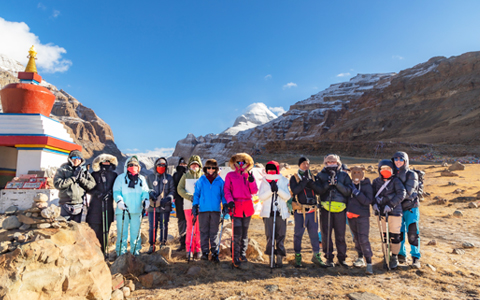


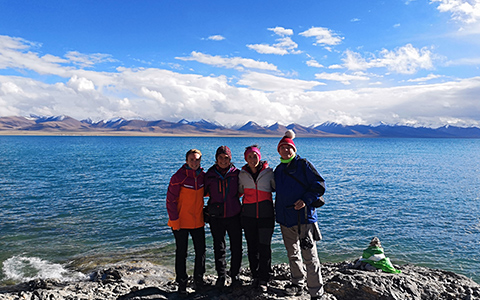
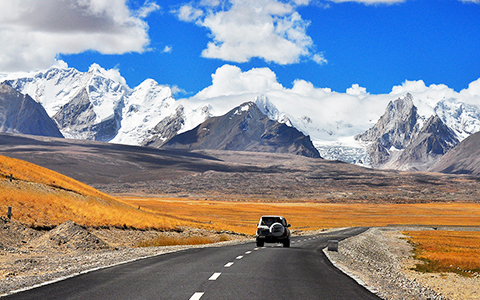




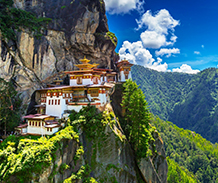










 The Tibetan mastiffs are charming and imposing.
The Tibetan mastiffs are charming and imposing.
 Tibetan mastiffs are cherished family members in Tibet.
Tibetan mastiffs are cherished family members in Tibet. Tibetan Mastiffs mostly live in the harsh Tibetan Plateau.
Tibetan Mastiffs mostly live in the harsh Tibetan Plateau. Taking photos with a Tibetan mastiff at Yamdrok Lake.
Taking photos with a Tibetan mastiff at Yamdrok Lake.








Ask a Quick Question